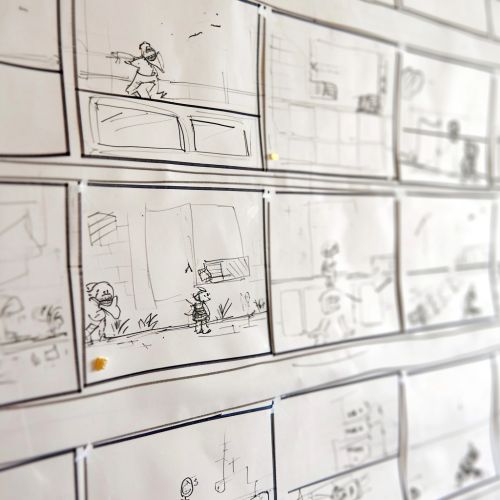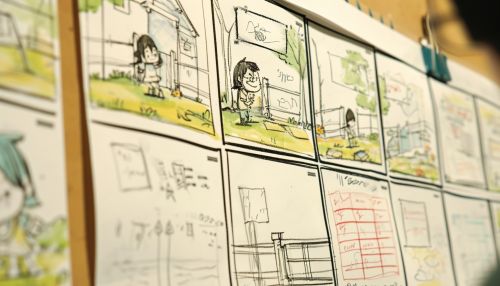Storyboard
Definition and Purpose
A storyboard is a graphic representation of how your video will unfold, shot by shot. It's made up of a number of squares with illustrations or pictures representing each shot, with notes about what's happening in the scene and what's being said in the script during that shot. It can be hand-drawn or digitally created.
Storyboarding is a crucial part of the pre-production process because it clearly conveys how the story will flow, as you can see all the scenes laid out in front of you. It allows you to see a visualization of the dynamics of your play, whether it be a film, television show, or animation.


History
The concept of the storyboard originated in the early 1930s at Disney to develop animated cartoon stories. The first storyboards were essentially comic strips, which illustrated the sequence of events in a linear fashion. The idea was borrowed from the comic strip industry and adapted to the needs of animation studios. This method was first used for a complete feature film in Snow White and the Seven Dwarfs.
Types of Storyboards
There are several types of storyboards, each with their own specific uses and benefits. The most common types include:
- Animation Storyboards: These are used in the creation of animated films or television shows. They are typically more detailed than other types of storyboards, as they need to convey motion as well as plot.
- Live-Action Storyboards: These are used in the production of live-action films or television shows. They are usually less detailed than animation storyboards, as they only need to convey the basic sequence of events and camera angles.
- Interactive Storyboards: These are used in the development of video games or other interactive media. They are similar to animation storyboards, but also include elements such as player interaction and branching narratives.
- Commercial Storyboards: These are used in the creation of commercials or other short-form video content. They are typically very detailed, as they need to convey a complete story in a short amount of time.
Process of Storyboarding
The process of storyboarding typically begins with a script or a basic outline of the story. The storyboard artist then translates this script into a series of images. Each image corresponds to a specific part of the script and is accompanied by a brief description of what is happening in the scene.
The images are usually drawn in a rough, sketch-like style, as the focus is on conveying the overall flow of the story, rather than creating detailed artwork. However, in some cases, particularly for high-budget productions, the storyboards may be more detailed and may even include color.
Once the storyboard is complete, it is typically reviewed by the director and other members of the production team. They may suggest changes or revisions to the storyboard, and the storyboard artist will then update the storyboard accordingly. This process may be repeated several times until everyone is satisfied with the storyboard.
Importance of Storyboarding
Storyboarding is an essential part of the filmmaking process for several reasons:
- Visualizing the Script: A storyboard helps the director and the crew visualize the script. It allows them to see how the scenes will play out, and how the shots will be composed.
- Planning the Shoot: A storyboard is a useful tool for planning the shoot. It helps the director and the crew determine what shots they need to capture, and in what order.
- Communicating the Vision: A storyboard is a way for the director to communicate their vision to the rest of the crew. It provides a clear, visual reference that everyone can understand.
- Saving Time and Money: By planning out the shoot in advance with a storyboard, the production team can avoid costly mistakes and save time on set.
